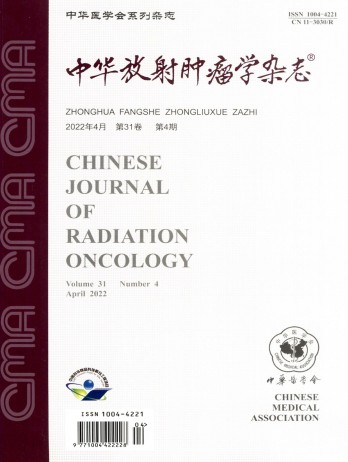癌症左侧DIBH患者放疗中两种设置误差测定方法的比较
引用次数: 0
摘要
目的建立光学表面监测系统(OSMS)在癌症左侧乳腺深吸气屏气(DIBH)放疗中应用的基本程序,并比较OSMS与锥形CT(CBCT)在判断癌症左侧乳腺深呼气屏气放疗设置误差中的作用。方法对20例癌症左侧乳腺癌患者进行DIBH放射治疗。通过CBCT图像与计划CT图像的配准,以及OSMS射线照相图像与体表外轮廓的配准,确定了沿外侧-内侧(Rx)、上下(Ry)和前后(Rz)方向的平移设置误差和旋转误差。Pearson相关分析用于评估两种方法确定的设置误差的相关性,Bland-Altman图分析用于评估这两种方法的一致性。结果两种方法呈正相关。在x、y和z方向上,Rz体积分别为0.84、0.74和0.84,在Rx、Ry和Rz方向上分别为0.65、0.41和0.54(均P<0.01)。对于两种方法,在Rx、Ry和Rz方向上,95%的一致性CI在预设的3°公差范围内——2.9°-1.4°、-2.6°-14.4°、-2.4°-2.5°。20例左侧乳腺癌癌症患者接受DIBH放疗的系统误差<0.18cm,随机误差<0.24cm。CBCT和OSMS相结合是一种安全可靠的方法。关键词:光学表面监测系统;深吸气屏息;图像注册本文章由计算机程序翻译,如有差异,请以英文原文为准。
Comparison of the performance of two methods to determine set-up errors for DIBH patients with left sided breast cancer in radiotherapy
Objective
To establish the basic procedures of the application of optical surface monitoring system (OSMS) in the deep inspiration breath hold (DIBH) radiotherapy for patients with left sided breast cancer and compare the performance of OSMS and cone-beam CT (CBCT) in the determination of the set-up errors of DIBH radiotherapy for patients with left sided breast cancer.
Methods
Twenty patients with left sided breast cancer received DIBH radiotherapy. Through the registration of CBCT images with the planning CT images, and the registration of OSMS radiography images with the outer contour of the body surface, translational set-up errors and rotational errors were determined along the lateral-medial (Rx), superior-inferior (Ry) and anterior-posterior (Rz) directions. Pearson correlation analysis was performed to evaluate the correlation of the set-up errors determined by two methods, and Bland-Altman plot analysis was used to assess the coincidence of these two methods.
Results
Two methods were positively correlated. The Rz volume was 0.84, 0.74 and 0.84 in the x, y and z directions, and 0.65, 0.41 and 0.54 in the Rx, Ry and Rz directions, respectively (all P<0.01). The 95%CI of agreement were within preset 5 mm tolerance (-0.37-0.42cm, -0.39-0.41cm, -0.29-0.49cm ) in x, y and z directions for two methods. The 95%CI of agreement were within preset 3 ° tolerance -2.9°-1.4°, -2.6°-1.4°, -2.4°-2.5°in Rx, Ry and Rz directions for two methods. The system errors of 20 patients with left sided breast cancer receiving DIBH radiotherapy were <0.18cm and the random errors were <0.24cm.
Conclusions
OSMS is equivalent to CBCT in the determination and stimulation of set-up errors for patients with left sided breast cancer receiving DIBH radiotherapy. The combination of CBCT and OSMS is a safe and reliable method.
Key words:
Optical surface monitoring system; Deep inspiration breath hold; Image registration
求助全文
通过发布文献求助,成功后即可免费获取论文全文。
去求助
来源期刊
自引率
0.00%
发文量
6375
期刊介绍:
The Chinese Journal of Radiation Oncology is a national academic journal sponsored by the Chinese Medical Association. It was founded in 1992 and the title was written by Chen Minzhang, the former Minister of Health. Its predecessor was the Chinese Journal of Radiation Oncology, which was founded in 1987. The journal is an authoritative journal in the field of radiation oncology in my country. It focuses on clinical tumor radiotherapy, tumor radiation physics, tumor radiation biology, and thermal therapy. Its main readers are middle and senior clinical doctors and scientific researchers. It is now a monthly journal with a large 16-page format and 80 pages of text. For many years, it has adhered to the principle of combining theory with practice and combining improvement with popularization. It now has columns such as monographs, head and neck tumors (monographs), chest tumors (monographs), abdominal tumors (monographs), physics, technology, biology (monographs), reviews, and investigations and research.

 求助内容:
求助内容: 应助结果提醒方式:
应助结果提醒方式:


